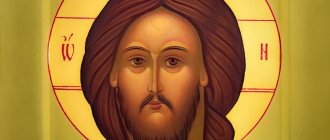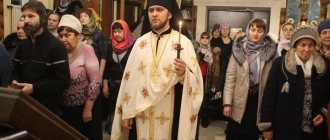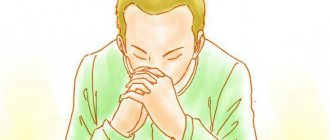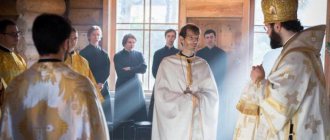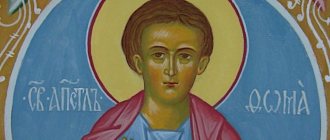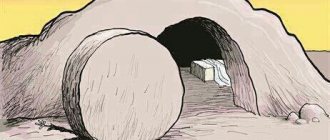Film The Monk and the Demon (2016): description, content, interesting facts and much more about the film
Ivan Semenovich comes to the monastery with one problem - it is on fire. The clothes themselves ignite on him, despite the fact that it is drizzling outside. The abbot of the monastery pours water from a bucket over him. Ivan asks to be allowed to stay in the monastery. After a short conversation, the abbot tells him to wash and clean up.
All the monastery servants notice Ivan’s strange behavior. It’s as if two different people live in it - one modest and meek, and the other impudent and sharp-tongued. The abbot tells Ivan that he will not feed him for nothing, and tells him to clean out the ancient well, which in the past was healing. The well is full to the brim of dirty water, and it must be drawn out to the bottom. Ivan’s modest nature is puzzled by such a test, but suddenly another playful essence awakens in him, to whom this work seems like a trifle.
In less than a day, Ivan manages to figure out the well. The abbot did not expect such inhuman agility from him. He begins to be suspicious of Ivan and tells another monk that he needs to inspect Ivan’s cell in his absence. The abbot also orders Ivan to confess. Ivan does not come to confession on time. He appears much later to confess personally to the abbot. Ivan’s strange speech during confession confuses the abbot, and he sends him to the river to get fish.
While Ivan goes to the river, the abbot with a couple of monks goes to his cell to search everything. In Ivan's bed they find a comb and scissors, and a scandal begins. Soon an important clergyman from the Tomsk province appears in the cell of the sleeping abbot. During a conversation with the abbot, he asks why he is persecuting Ivan, who is practically a holy man. A man from the Tomsk province advises the abbot to keep Ivan close to him and give him the opportunity to participate more in the management of the monastery, since he can increase his income several times. Then the clergyman leaves.
The abbot jumps out after the stranger from the cell and asks the clerk about him, but he says that he saw a woman. This fact puzzles the abbot. Running out into the yard, he sees a woman leaving, who then disappears. Then Ivan returns from the river with a huge fish. The abbot orders Ivan to be tied up, gagged and taken to the pier. There they put him on a raft and let him float down the river. However, the raft with Ivan returns back to the pier against the current. The abbot understands that they cannot get rid of Ivan. He is returned to the monastery and forced to do laundry because he is so friendly with water.
Suddenly, Nicholas I arrives at the monastery. The English spring on his carriage has broken and needs to be repaired. The Emperor asks the Abbot if he has a person who can repair the carriage. The abbot replies that he does not have such people. Then the emperor asks to shelter them for a while. At dinner he is served the same fish that Ivan caught. At the table they talk about miracles in the monastery. The Emperor learns about Ivan and expresses a desire to see him. Ivan seems to the emperor an interesting person, well versed in many things. Finally, he receives advice from Ivan about the spring - “what is not repaired with umami, is repaired with drool.” This phrase greatly amuses the emperor, after which he goes to the carriage, slobbers on a handkerchief and wipes the spring with it, and then goes to bed.
After a conversation with Ivan, the sovereign decides to reduce the number of serfs, and also give the peasants their own plots of land. In the morning the spring turns out to be intact, as if it had never broken. Before leaving, the sovereign asks the abbot to give Ivan the ring. The abbot goes to Ivan and sees how he throws his dirty clothes into the water, and they wash themselves in the river. This scares the abbot. He gives Ivan the ring and sends him to live in the settlements. Having brought Ivan to the place, the abbot orders him to cut down all the dead trees, and number those that are healthy.
When Ivan is left alone, another person emerges from him. Ivan asks the demon that has appeared in human form to leave him alone. But he says that Ivan is promising, and that he will make him the abbot of this monastery. The demon says that his name is Legion. In the morning, Legion arranges a sumptuous breakfast for Ivan, but he refuses to eat with him. The Legion asks Ivan to sign a denunciation against the abbot of the monastery. Ivan says that the denunciation must be anonymous and signs it with a cross, after which the paper instantly burns.
For this, the Legion ties Ivan to a tree and makes a fire under him. The Legion wants to deal with Ivan, but then it suddenly starts to rain and puts out the fire. Then Legion decides that this is even to his advantage; now he wants to try to break Ivan on some weakness so that he begins to dance to his tune. Ivan tries to turn to God in order to understand his plan, since he himself cannot get rid of the demon and does not know what to do. The Legion, meanwhile, carries out the assignment that the abbot left for Ivan. Soon the abbot arrives and is frightened by the fact that Ivan again completed his task so quickly. Ivan tries to explain to the abbot that it was not he who did this, but he quickly drives away.
The Legion invites Ivan to see Jerusalem. He agrees to bow to the demon and give him his soul in order to visit the Church of the Holy Sepulcher. The demon picks up Ivan and rushes into the sky to fly to Jerusalem faster. There they end up at the bazaar, where they sell various things, passing them off as objects related to Christ. Ivan thinks this is blasphemy. He starts overturning tables of goods and ends up getting beaten up. Legion heals him.
Before going to the temple, Legion goes to file his antlers and get himself in order. Ivan tries to refuse to go to the temple, but the demon forces him to keep his word. The demon himself does not want to enter the temple. However, Ivan simply forces him there. After a night in the temple, Ivan carries Legion's lifeless body out of there. Ivan tries to heal Legion - he takes him to the Dead Sea. After visiting the temple, Ivan's lameness goes away and he stops stuttering. At the Dead Sea, the Legion begins to recover. The Legion does not have the strength to fly back. Ivan forces him to give up the emperor's ring so that they can get on the ship and return.
When they return back, they are arrested and considered suspicious. During interrogation, Ivan begins to confess to everything he did not do. For lying, they and the Legion are ordered to be flogged. And then they are locked in a small house. The Legion tries to heal Ivan's wounds, but suddenly it turns out that he has lost his magical powers. Here Ivan begins to die. Legion sees how the soul leaves Ivan, but cannot do anything.
The legion goes to the same monastery to the abbot. He asks to be sheltered within the walls of the monastery and says that he is ready to do any work. The abbot, hearing his name, calls him Lazarus. And he tells him to do the laundry, where Ivan used to work. Legion is glad that he was allowed into the monastery. The clerk does not approve of the abbot's behavior, saying that he is letting all sorts of trash into the monastery. But he is sure that he is doing the right thing.
www.ivi.ru
Nikolay Dostal spoke about his film “The Monk and the Demon”
The idea for the film appeared after reading a book about the monks of the Nilo-Sora desert of the 19th century and the life of St. John of Novgorod.
Director Nikolai Dostal told the participants of the Pokrov film festival about his film “The Monk and the Demon.” The meeting with the metro took place on October 10 at the Kiev Cinema House, reports Foma.in.ua.
According to the director, the idea for the film appeared after reading a book about the monks of the Nilo-Sora desert of the 19th century (in particular, the memoirs of the ryassophore Ivan Semenovich Shapochnikov) and the life of St. John of Novgorod. Saint John once caught a demon in a washstand, he prayed: “Let go.” The saint replied: “I will let you go if you take me to the Holy Sepulcher in Jerusalem.” He brought it, but then began to take revenge on the monk.
A similar plot, as it turned out after finishing work on the film, is found in the works of Alexander Pushkin (the story “The Monk”), where there is also a dialogue between a monk and a demon about a journey to the Holy Land.
The sayings often heard in the film were taken by the screenwriter Yuri Arabov and the director from the lives of saints.
During the filming of the film, believers of one of the churches in the Vologda diocese, having learned that a film with the same name would be filmed near it, came out in protest. “They didn’t know that the film was Orthodox,” the director noted. And those who knew supported it, including the bishops.
Most of the shooting days (filming lasted about 2 months) took place on the territory of the Kirillo-Belozersky Museum-Reserve, as well as in the city of Petra (Jordan) and in the Crimea, which for a time “became” the Holy Land.
Nikolai Dostal also told a parable - “the key to the film.” A tired monk comes to his cell, all he can think about is to lie down to rest and sees that the devil is lying on his couch. “Apparently, he’s also tired, poor fellow,” thought the monk and lay down under the couch. As soon as he lay down, the demon flew out of the cell like a bullet.
“You can fight evil with love. Not only “kindness with fists”, but also love. When people ask me what the film is about, I answer: “About love. About love for the world. To near and far. To the enemies of the human race. As the Almighty willed, so it is.” This is what our movie is about. And I would like him to be perceived that way,” said Nikolai Dostal.
“The Monk and the Demon”, 2021, Russia.
Director: Nikolay Dostal.
Script: Yuri Arabov.
Starring: Timofey Tribuntsev, Georgy Fetisov, Boris Kamorzin, Roman Madyanov, Nikita Tarasov, Sergei Barkovsky.
Fantastic story of the first half of the 19th century. A new monk, Ivan Semenovich, appears in the monastery. But along with the monk, dark forces penetrate the monastery, which materialize in the person of the Legion (this is how he introduced himself to Ivan). The Legion chose Ivan as the object of its devilish work, tempting him in every possible way in order to lead him astray from his chosen path of serving God. But the stronger the temptation, the stronger Ivan’s spiritual strength.
Interesting: the actor Georgy Fetisov, who played the demon of the Legion, is a believer and has been to Mount Athos twice.
By the way: His Beatitude Metropolitan Onuphry, when he heard the title of the festival’s opening film “Pokrov,” said: “Oh, this is what I see every day.”
pravlife.org
At the MIFF they asked, can the devil become a man?
"The Monk and the Demon"
Russia, dir.
Nikolai Dostal, starring: Timofey Tribuntsev, Georgy Fetisov, Boris Kamorzin, Nikita Tarasov, Sergei Barkovsky, Roman Madyanov. Movie page
A limping, stuttering, and most importantly, literally burning Ivan, Semyonov’s son from Torzhok, comes to the secluded monastery. “Why are you burning?” - the abbot is interested. “By sins,” Ivan does not lie, admitting that he is truly sinful - both because he loves all living creatures, and because he is wise beyond his years.
However, here’s the thing: along with a new novice, miracles come to the monastery. Ivan manages to solve the task of cleaning a well given for two weeks in half a day, with just one prayer he catches a giant fish in the river, washes his trousers with a wave of his hand, and how he irons them!.. Who knows, maybe this is a saint who will be canonized in fifteen hundred years years?.. Or, pah-pah-pah, there was some demonic presence here?..
Trailer for the film “The Monk and the Demon”
The first thing you should know about this film (especially in a festival context): this is the long-awaited and more than deserved benefit performance of Timofey Tribuntsev, an excellent actor who has been familiar in cinema for quite some time, but, as a rule, in the background. His first appearance turned out to be excellent: the role was bright, juicy, with great amplitude and a lot of possibilities.
The second thing that is important: “The Monk and the Demon” does not pretend to be a historical film, despite the fact that one of the heroes here is the Emperor Nikolai Pavlovich, and in Ivan’s story about two writers, Gogol and Pushkin are unmistakably guessed. “I would like to see modernity in this film, this is the main thing,” says director and author of the idea Nikolai Dostal, but he might not even say: this modernity with all unconditional recognition manifests itself, if not in action, then in dialogues .
Still from the film “The Monk and the Demon”
Here the abbot is dictating a letter to a superior ruler, but the clerk advises not to go into details: the addressee may take the mention of a fattening bear personally, and besides, it is better to do without bitter statistical details - otherwise they will send you away.
Later, the same abbot tells the tsar: “We don’t need roads at all, and are even very harmful,” explaining: “Because there will be roads, and the enemy will drive along them and get straight into the heart of Russia.” The king himself, talking about our eternal troubles, hunger and crop failure, rhetorically asks: “Who is to blame?..”. And when it comes to introducing taxes from breeders, he admits: “They steal.” Yes, only theft - “is this a sin in Russia?”
“You are a statesman, and commercial interests are superfluous here,” Nicholas I criticizes Benckendorff, who took on, let’s say, additional work in financial enterprises. And to the question of what the landowners will say about the peasant reform, the answer is generally simpler: “They will say: “Glory to the Sovereign Emperor,” and if they don’t say it, they will regret not saying it.” Against this background, one is no longer surprised at the characterization of Satan given by the demon in the title: “A very effective leader.”
Few of the paintings directly dedicated to today are as topical and relevant as this one.
Still from the film “The Monk and the Demon”
Although, most likely, there will be more discussion about its religious and spiritual component. Well, what could we do without it, if the film is called “The Monk and the Demon”?.. Of course, there are plenty of quotes on this topic: “God builds a church, but the devil builds a chapel”, “Faith is how a person lives”, “Not everything is sacred that is pressed into the book,” and the “secret of lawlessness” is partly familiar to us: “If you do not love, you will not be loved.”
Another, purely cinematic (and, admittedly, very unexpected) distinctive feature of the film is the unusually clever (for our cinema!) use of special effects. For many episodes, you won’t even understand exactly what it was: a real miracle or computer intervention. Tired, however, is in no hurry to reveal secrets, joking when asked directly: “Everything was filmed on location, no special effects.” Journalists understand the joke and support it by shouting: “With God’s help.”
Interview with Nikolay Dostal to the press service of the 38th Moscow Film Festival
In general, Dostal is not inclined to talk much about his work, being confident that “the picture itself must communicate with the viewer,” while now that the film has already been presented to the public, “the director must remain silent.” Therefore, when he came to the press conference, he answered critics’ questions sparingly and only touched on “technical” topics.
Dostal again spoke about the difficult fate of the project (five years since the idea appeared and a long search for financing); mentioned that so far “no serious comments” have been made by church representatives who have seen the film; recommended everyone to visit the filming locations - the Kirillo-Belozersky Museum-Reserve in the Vologda province (an interesting coincidence: he filmed his “Little Demon” there).
When he was asked to clarify what exactly the original idea was, Dostal remembered a phrase he once liked from Yuri Arabov, which today sounds like a ready-made advertising slogan:
Can the devil become a man? And the devil knows.
Still from the film “The Monk and the Demon”
As we already reminded you when announcing the festival, Nikolai Dostal’s wonderful film “Peter on the Road to the Kingdom of Heaven” won at the MIFF in 2009. But few are likely to compare in frequency of appearance in our competition with film playwright Yuri Arabov: “The Monk and the Demon” is already the fifth film based on his script to take part in the main program of the Moscow Film Festival over the past twenty years (before that there were “Mother and Son ", "Miracle", "Horde" and last year "Orleans").
Today, Arabov is grateful to Dostal that he fought for the film for so long, refusing the television series offered to him (“This is the first time in my life that I have met with such loyalty”). He does not deny that in this scenario there were echoes of his own “Faust”, and recalls the invariable property of the Russian soul - to keep faith and unbelief in one package: “In Russia, atheism is of a purely religious nature.” However, in his opinion, young people should now understand the Russian soul: after all, they will have to “try to make this life no worse.”
Dostal also agrees with him:
Honestly, I always wanted more young people to watch the film. They continue to live, they continue to build something in this world.
However, the film’s producer, Igor Tolstunov, assesses the distribution prospects skeptically, without false optimism - believing that if the film manages to achieve the results of the film “The Island,” then it will “be very good.” These days the picture begins to be presented to cinemas, and “The Monk and the Demon” will be released to a wide audience in early autumn, on September 8th.
Still from the film “The Monk and the Demon”
"The Monk and the Demon" (2016)
This is my first negative review of the film and I will immediately start by revealing the negative component in order to substantiate my claims. So, the film is a parable - this is how most define the genre type of this film. Consequently, in the key characters and the action itself, it is necessary to look for the “second bottom”, something that could be expressed covertly. And this “something” is found without difficulty. First of all, in the figure of the demon. In the behavioral traits of this character one can easily guess the typical properties of a white-ribbon oppositionist with glamorous manners. He tempts the monk with delicacies such as foie gras; he is a “minor demon”, and his “patron” (performed by Madyanov) gives the impression of a corrupt official, and, moreover, not a local one; finally, he tempts him abroad, where it’s true he’s never been, but he’s heard a lot from his “grandmother”; Once there, in the Holy Land, he easily mimics and gives the impression of a local man in the street: in Russia he was a miracle-juda, but here he is not able to surprise even an aborigine barber with the presence of horns on his head - “there aren’t many of you like that here, or what?” Now about the monk. A completely nondescript, passable figure, in my opinion. A synthetic, collective image that does not have a single original expressive feature for which it could be remembered and distinguished. Here he prays, in the words of his “contemporary,” the wise Saint Philaret: “I offer myself as a sacrifice to You; teach me to pray. Pray in me yourself,” but he behaves like a holy fool or just a rogue; gives “senile advice” to the Emperor; with an incomprehensible force, he works miracles, and, moreover, completely farcical ones, giving him the features of the fairy-tale Emelya or Ivan the Fool. And of course - love! The character is supposedly filled with universal love, including for the demon, even and first of all, by his own admission. In this he surpasses the Lord, who teaches to hate Satan and turn away from his deeds, but he reveals the Platonic idealism of the film’s authors: after all, the “idea” of Satan is the beautiful Lucifer, God’s favorite, Dennitsa! And in general, everything at its core is beautiful and amazing. Such an inescapable stamp of an idealist-intellectual, acquired at the time of neophyteism and completely leading him away from reality into this very simulacrum of an ideal that does not exist. Now about the composition and plot. Well, I have the strong impression that the director or screenwriter simply needed to “marry” - “a white rose with a black toad” and they crown them, with joint efforts, no matter how stupid and ridiculous it may look. That's all about composition and plot. Noticeable is Emperor Nicholas I, who somewhat stands out from the general background with his emphasis on the authenticity of the image. And here there are some stereotypes: the troubles of Russia, who is to blame, fools and roads, and so on. But the main feature of Nikolai’s “similarity” to any head of our state is his “understanding” of the people, his intuitive grasp of the “people’s soul”, their aspirations or even orders and, at the same time, with an absolutely impassable distance between them. Well, that’s all. In my opinion, the film could have turned out deeper and wider, but it didn’t work out, due to naive idealism, understatement, lack of a clear position, etc. As a feature film, it’s a completely acceptable film, but as a candidate for prizes in competitions aiming for something other than something that will be “eaten” with popcorn, it’s overkill.
6 out of 10
www.kinopoisk.ru
What kind of prayer is in the movie The Monk and the Demon
“Lord, I don’t know what to ask of You. You alone know what I need. You love me more than I can love myself. Father, give to Your servant what I myself cannot ask for. I do not dare to ask for either a cross or consolation, I only stand before You, my heart is open; You see needs that I don't know. See and create according to Your mercy; strike and heal, overthrow and raise me! I am in awe and silent before Your holy will and Your destinies, incomprehensible to me. I offer myself as a sacrifice to You; teach me to pray. Pray in me yourself. Amen.”
In the film “The Monk and the Demon,” directed by Nikolai Dostal, the daily prayer of St. Philaret, Metropolitan of Moscow, is heard.
The prayer is beautiful and well read by actor Timofey Tribuntsev, who played one of the main roles in the film.
Dear Tashenka Dronova, why slave, we are sons of God. Lay me down and raise me up, here you are also wrong, this is not your Tashenka’s prayer, asking and raising me is not given to everyone, I hope you have risen. Strike and heal too, people think about every word, a man read this prayer for the Lord, and you read it for yourself.
Religious reading: the prayer of a monk in the film The Monk and the Demon to help our readers.
However, he never thought about the reasons why he became an intermediary between all worlds. After all, such a great gift cannot appear out of nowhere. Ivan begins to investigate the history of his ancestry, which leads to big and terrible discoveries. Ivan understands that from his very birth he was destined for a destiny: to be in the middle between God and the Devil. Will he be able to cope with such a difficult mission and not tip the scales to one side?
Duration: 113 min. / 01:53
IMDb rating: 6.9 (542 votes)
Visitors in the Guests group cannot leave comments on this post.
Repeatedly in his interviews, Nikolai Dostal himself points out that the main impetus for the idea of creating the film was his acquaintance with the life story of Ivan Semenovich Shaposhnikov, a former inhabitant of the Nilo-Sora monastery. As we can see, the author of the picture even borrowed the name for his main character from him - Ivan, Semenov’s son. What is known about this wonderful holy fool ascetic?
Ivan was born in 1802 in the city of Galich, Kostroma province, into a family of burghers. It is known that he had a talent for icon painting and craftsmanship, which he did in his youth. However, at the age of eighteen, he had to give up this occupation dear to his heart: due to paralysis, his right arm and legs were affected, until the end of his life he could no longer use them freely, he moved only with the help of a stick. But even in this, the young man saw the clear providence and will of God and decided to leave this vain world, going to a monastery.
Ivan’s first refuge was the Kirillo-Novoezersky Monastery. Here, however, he did not stay long, since his illness did not allow him to carry out harsh labor obediences. Expelled from this monastery, the novice came to the Nilo-Sora Hermitage, located nearby, where he spent all his remaining years of asceticism. The abbot of the monastery, Hieroschemamonk Neil, quickly recognized in the young novice the wondrous chosen one of God, and they soon became spiritual associates.
Soon, novice Ivan Shaposhnikov, ascending from strength to strength, was able to acquire such necessary, but rare qualities even for monastics, as humility, absolute kindness and non-covetousness. Moreover, the gift of love inherent in him also extended to all of God’s creation. The brethren noticed that while being obedient in the refectory, he even fed cockroaches out of pity: crushing and soaking bread specifically for these purposes, Ivan Semenovich put them in those places where there were the most insects. He carried out his obedience in the refectory for twelve whole years, while the kitchen replaced his cell, and here he slept on the stove, covered with boards. The novice’s clothing was unchanged: at any time of the year he wore the same cassock, and usually did not wear shoes.
It is not surprising that the saint had to endure much ridicule and bullying from the younger brethren. He endured all this calmly, never got angry or offended, very often covering up his feat with foolishness.
Over time, still remaining in the ranks of novices, Ivan Semenovich was awarded some grace-filled gifts. For example, the gift of insight: often the invisible world was revealed to him. He knew which of the brethren were distracted by obscene thoughts during prayer, and he meekly rebuked them. The seer noticed that fire was coming from the mouths of the fervently praying monks. The saint also saw how the newly tonsured are usually followed by two angels. There is a known case when one day during a meal, Ivan Semyonovich laughed loudly when he saw how an angry monk who was inattentive to reading was saddled by a demon and rode him.
Just as a city standing on top of a mountain cannot hide, so the unusual seer soon became known throughout the area. People with their sorrows and illnesses began to come to Ivan Semenovich. He accepted them with love, but quickly became burdened by such worldly fame. With the blessing of the abbot, he built himself a remote cell in a swamp and there he continued to carry out his feat.
It is clear that the success of the wondrous old man could not be hidden not only from people, but even more so from the enemy of the human race. He tried in every possible way to turn him away from serving God, to confuse him. Even when Ivan Semyonovich was obedient in the refectory, demons repeatedly appeared to him in reality in their terrible form. The brethren often heard strange sounds coming from there, and the next morning they found the novice covered in bruises, barely alive. The demons lifted him above the ground and forced him to dance. However, the warrior of Christ did not succumb to them. Sometimes these attacks were so terrible that he asked one of the brethren to stay with him in the kitchen overnight.
When Ivan Semenovich moved to a remote cell, the demonic insurance and bullying only became more severe. One day, when he was returning to his place after the evening rule, a terrible Ethiopian attacked him in the forest with a club and beat him so much that the novice lay unconscious for a long time. The scar from the blow to the head remained with him for the rest of his life.
However, unexpected help and consolation in the struggle soon came. One evening, Archdeacon Stefan appeared to the elder in his cell and pointed to the copper cross, saying that with it he would defeat demons. Before this, Ivan Semenovich’s cross lay neglected, since it was eight-pointed, and the righteous man believed that the correct cross should only be four-pointed.
This was not the last wonderful visit of the ascetic. During a serious illness, he was also honored with the appearance of the Lady Herself, accompanied by the holy virgins: the Venerable Anastasia and the Great Martyr Catherine. From her own Most Pure hands, the Queen of Heaven gave the old man cabbage soup with black bread (his only dish), after tasting which he immediately recovered.
But the years of Ivan Semenovich’s earthly life were still coming to an end. He died on May 13, 1863. And only six years before his death he was tonsured into the ryassophore.
In addition to this event, a whole series of various traditions and legends are associated with the name of John of Novgorod, of which there are about 150 in total. The journey to Jerusalem on a demon is one of the most vivid and famous stories, included even in the life of the saint.
Burned by the power of the sign of the cross, the unclean man began to ask John to let him out of the laver. Then the archbishop replied that he would do this only if the demon took him to the Holy Land and back. The imp agreed and, taking the form of a horse, fulfilled his promise, taking the archbishop to Jerusalem and back in one night. There the saint was able to visit the Church of the Resurrection of Christ, the entrance to which was opened through his prayers, and venerate the Holy Sepulcher, as well as all other shrines.
We exist solely on donations, so if you like our project, support us in a way convenient for you!
(You can specify the amount yourself)
